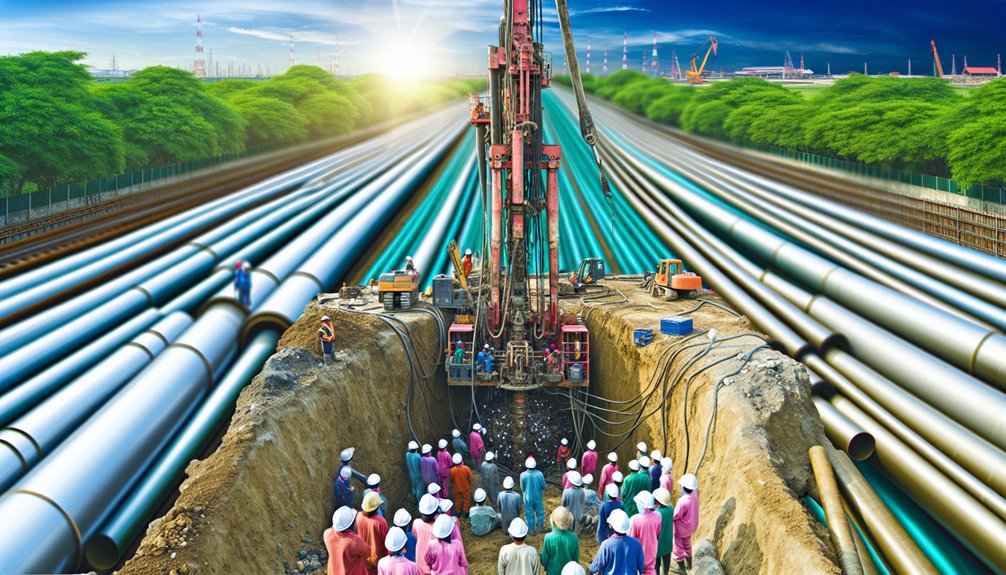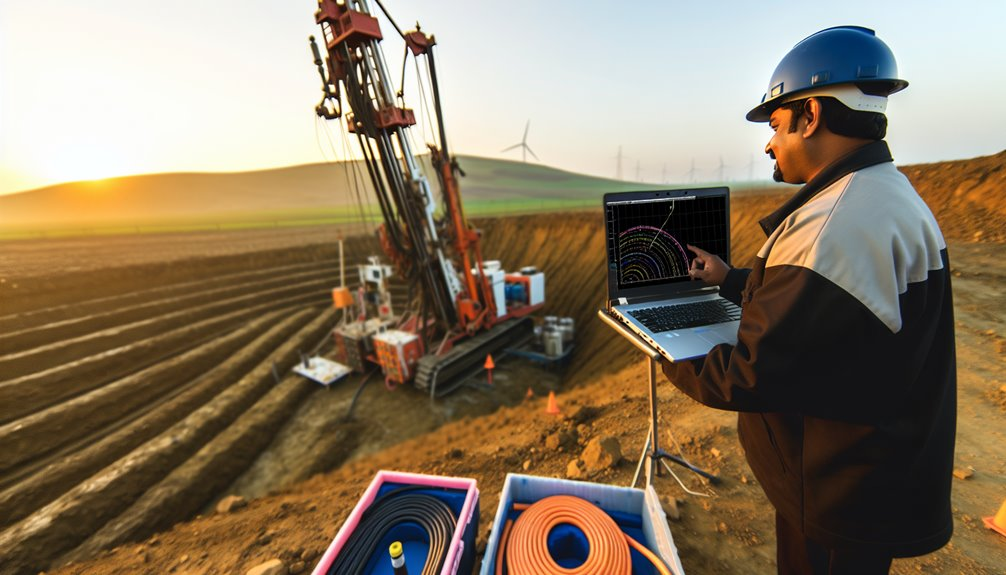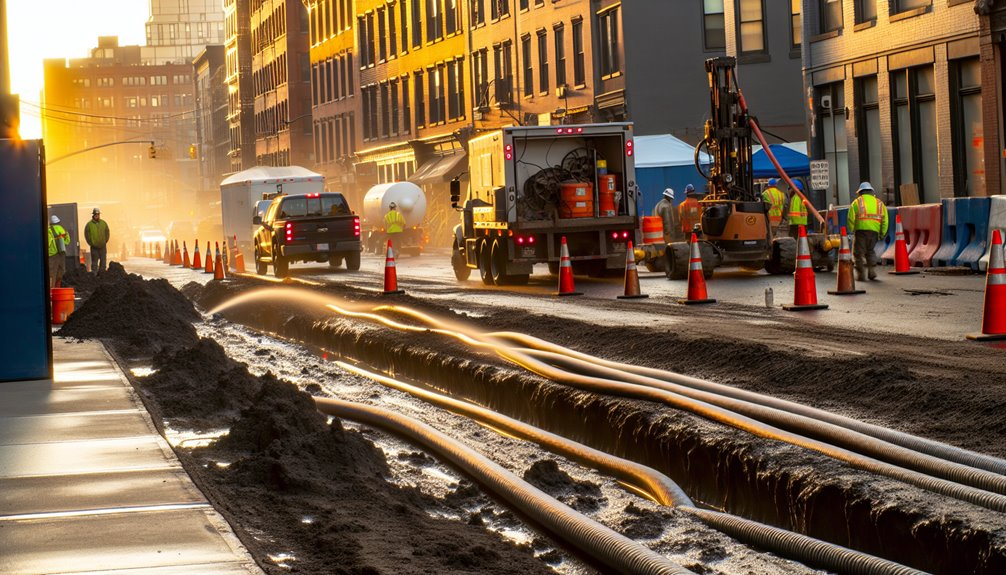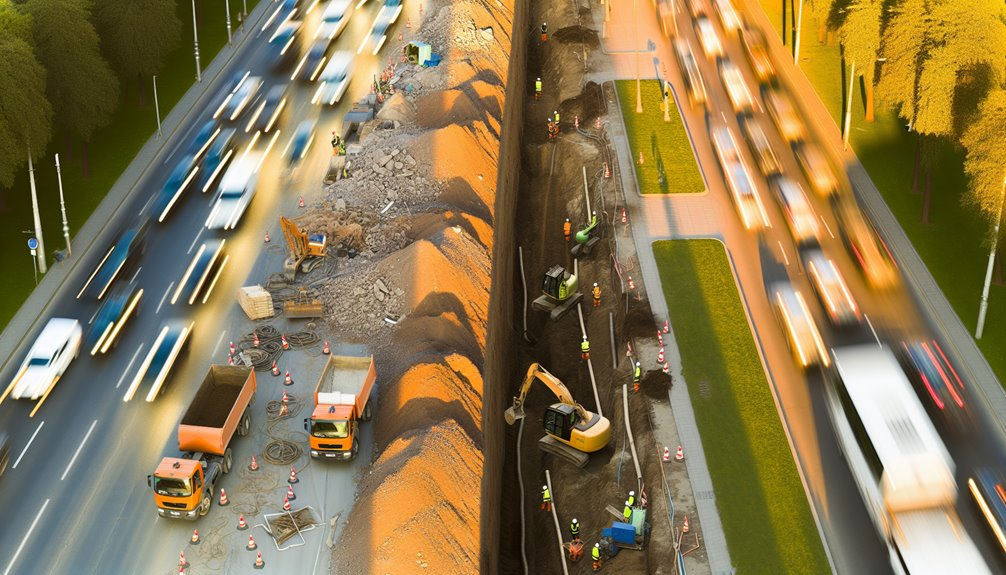As you explore the advancements in modern infrastructure, consider how Horizontal Directional Drilling (HDD) revolutionizes the way we install underground utilities. By employing HDD, you're opting for a method that greatly minimizes surface disruption compared to traditional trenching techniques. This precision-driven process not only preserves the surrounding environment but also streamlines the installation in densely populated or ecologically sensitive areas. Reflect on the strategic advantages this could offer in your next project, especially when maneuvering through stringent regulatory landscapes.
Understanding Horizontal Directional Drilling: Basic Principles and Mechanisms
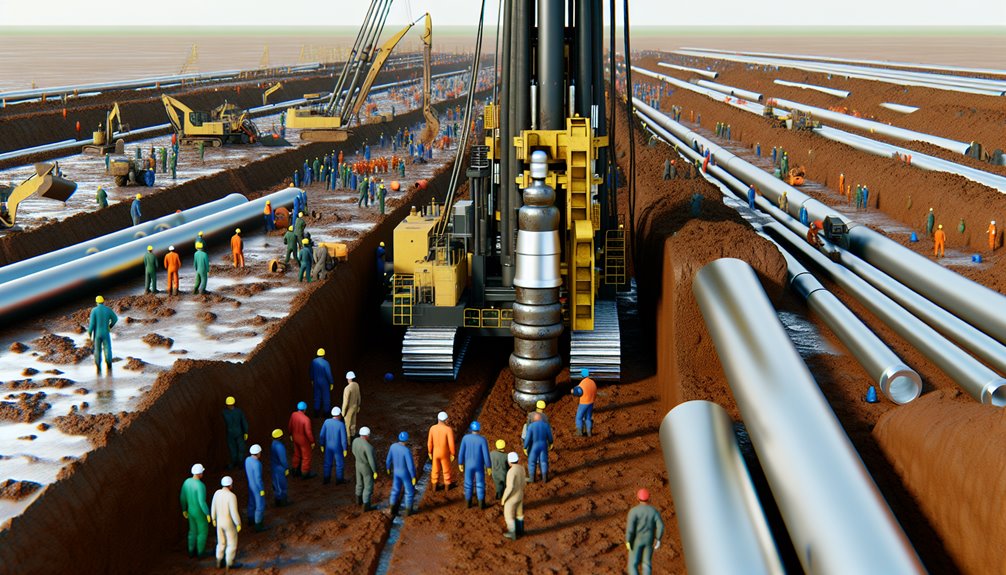
Horizontal Directional Drilling (HDD) is a sophisticated technique vital for the installation of pipelines and conduits beneath obstacles like rivers or urban areas without disturbing the surface.
You'll start by employing pilot hole techniques, where a small diameter hole is drilled using a directional machine. Real-time tracking systems guarantee the pilot hole adheres to a predetermined path, adjusting for depth and alignment.
Subsequently, you'll engage in reaming strategies. This involves enlarging the borehole through a process known as pre-reaming, necessary for accommodating the product lines.
A reamer attached to the drill string cuts and removes solids incrementally, guaranteeing a stable enlarged hole. Bentonite and additives in the drilling fluid help maintain hole integrity, essential for the next stages of the HDD process. During this stage, the diameter of the borehole is increased step by step using successively larger diameters to ensure the pipeline fits perfectly.
The Environmental Advantages of HDD in Urban and Rural Projects
As you explore the incorporation of Horizontal Directional Drilling (HDD) into your infrastructure projects, consider its significant environmental benefits.
HDD minimizes ecological footprints by allowing installations beneath existing landscapes, thereby preserving natural habitats and reducing surface disruptions.
This method not only maintains the integrity of urban and rural ecosystems but also aligns with stringent environmental regulations, promoting sustainable development practices. Moreover, the use of HDD supports the preservation of green spaces and landscapes, mitigating the impact of construction on delicate ecosystems.
Minimizing Ecological Footprints
While Horizontal Directional Drilling (HDD) revolutionizes infrastructure development, its most significant advantage lies in its ability to minimize ecological footprints in both urban and rural projects.
By minimizing surface disturbance, HDD preserves green spaces and ecosystems, aligning with sustainable development goals. It reduces the need for heavy equipment and extensive manual labor associated with traditional trenching, decreasing the impact on local environments and communities.
HDD supports eco-friendly practices by bypassing underground obstacles, thereby avoiding sensitive areas and minimizing soil erosion and habitat destruction.
This method not only protects ecological balances but also promotes the use of sustainable materials. Efficient waste management through regulated disposal of drilling fluids further guarantees minimal environmental impact, making HDD a cornerstone of sustainable infrastructure development.
Preserving Natural Habitats
Preserving natural habitats stands as a significant benefit of utilizing Horizontal Directional Drilling (HDD) in both urban and rural infrastructure projects.
By enabling installations beneath sensitive environments like rivers and forested areas, you're actively participating in habitat conservation. HDD guarantees the ecological integrity of wetlands and waterways by avoiding direct disturbance, allowing natural flows and ecosystems to thrive undisturbed.
In addition, the technology supports the preservation of wildlife habitats and prime agricultural lands by minimizing surface impact, thereby maintaining biodiversity and land productivity.
This technique not only respects challenging terrains and steep slopes but also aligns perfectly with efforts to conserve ecological corridors, essential for maintaining the health and connectivity of natural habitats.
Reducing Surface Disruptions
Building on the theme of minimal environmental impact, Horizontal Directional Drilling (HDD) offers distinct advantages in reducing surface disruptions during infrastructure projects.
You'll find that HDD addresses both urban challenges and rural benefits effectively.
- Minimizes urban surface excavation, preserving the integrity and aesthetic of city landscapes and public areas.
- Maintains traffic flow by avoiding disruptive open-cut methods, enhancing daily urban life.
- Protects rural landscapes from damage, preserving ecosystems and maintaining soil stability.
- Prevents water contamination and other hazards in sensitive rural and agricultural zones.
- Navigates beneath existing infrastructures such as roads and pipelines without surface disturbances, boosting project efficiency and safety.
These points underscore HDD's role in fostering sustainable and less invasive infrastructure development.
A Comparative Analysis: HDD Versus Traditional Trenching Techniques
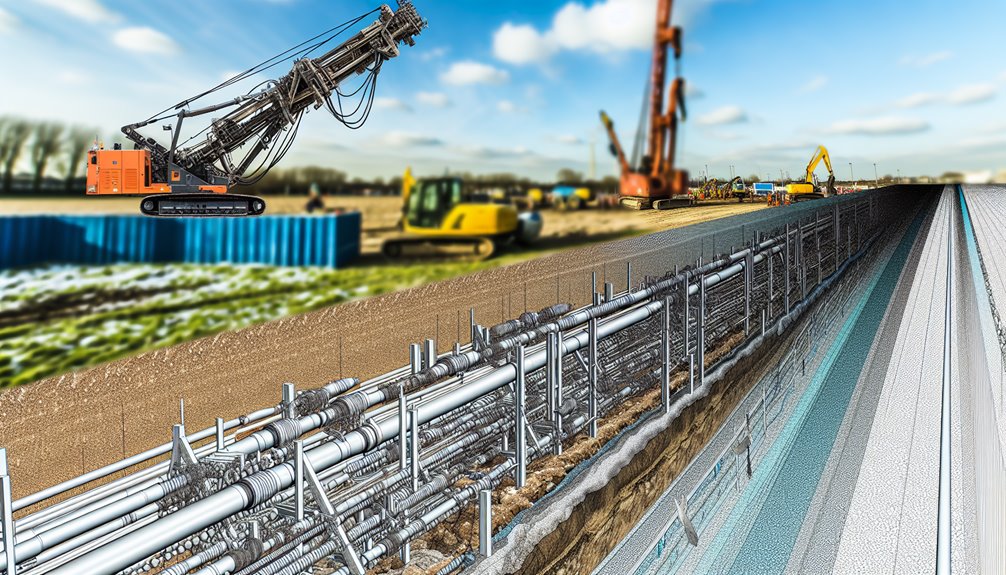
When comparing horizontal directional drilling (HDD) with traditional trenching techniques, it's clear that each method brings distinct advantages and challenges to infrastructure development.
HDD's advantages include less environmental impact, as it preserves landscapes and mitigates damage to existing structures, thereby aligning with stringent regulatory standards. It also offers enhanced efficiency, with faster completion times due to minimal restoration needs, and improves safety by reducing trench-related accidents.
However, HDD's disadvantages shouldn't be overlooked. The technique incurs higher initial costs due to expensive equipment and the need for specialized training. It also presents technical complexities, requiring precise real-time monitoring and navigation skills to avoid damaging underground utilities, which can escalate project costs and duration if mishandled.
Key Equipment and Technology in Horizontal Directional Drilling
Horizontal Directional Drilling (HDD) relies heavily on advanced equipment and sophisticated technology to successfully execute underground installations with minimal surface disruption.
As you explore this field, you'll discover the vital role of specific drill rig components and tracking technology:
- Drill Rigs: Varying in size, these rigs are equipped with essential components like mud pumps and control cabs.
- Drill String: Includes a drill bit and sonde housing essential for precise drilling.
- Tracking Technology: Utilizes gyroscopic systems and downhole sensors for accurate path guidance.
- Real-Time Monitoring: Guarantees continuous operation feedback, allowing for immediate adjustments.
- Advanced Steering: Facilitates precise directional control over extended distances, essential for maneuvering through complex underground landscapes.
Step-by-Step Process: Executing an HDD Operation
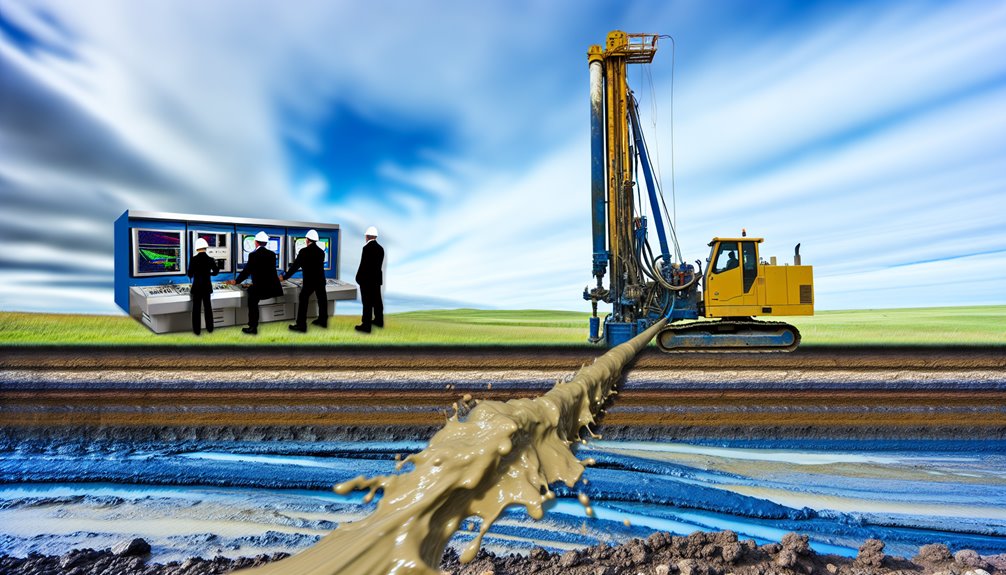
You'll begin the HDD operation by meticulously planning and designing the pathway, considering geological and environmental factors to optimize the drilling trajectory and minimize disruptions.
Next, you'll execute the drilling in distinct phases: initiating with a pilot hole, followed by successive reaming to widen the bore to the required diameter, and culminating with the precise pull-back of the pipeline.
Each stage demands rigorous adherence to technical specifications and real-time adjustments based on subsurface feedback and monitoring data.
Planning and Design Considerations
Initiating an HDD operation requires meticulous planning and design to guarantee efficiency and safety.
You'll navigate through complex site constraints and conduct a thorough risk assessment before drilling commences.
Here's a quick guide to streamline your planning phase:
- Site Assessment: Thoroughly inspect surface and subsurface conditions, identifying sensitive areas and existing infrastructures.
- Equipment Selection: Choose equipment that suits the site's specific needs and layout constraints.
- Design Integration: Incorporate precise geological and topographical data to tailor the HDD path.
- Regulatory Compliance: Adhere to safety and environmental regulations to mitigate impacts.
- Future Proofing: Consider potential area developments to guarantee long-term project viability.
Each step is critical for predicting challenges and optimizing your HDD strategy.
Drilling and Installation Phases
Once the planning and design stage is complete, the drilling and installation phases begin, marking a critical progression in executing an HDD operation.
You'll start by creating a pilot hole, utilizing advanced drilling techniques that involve a small diameter drill bit guided by an electronic transmitter. This guarantees precision as you monitor the drill path's parameters closely.
Next, you'll enlarge this pilot hole through pre-reaming, employing progressively larger reamers and continuous slurry injection to maintain borehole integrity. This meticulous installation method prepares the pathway for the final pullback operation.
During pullback, the pipeline is carefully drawn back, with drilling fluids providing essential lubrication.
Your skilled execution guarantees the pipe's ideal placement and functionality, culminating in rigorous pressure testing and site cleanup.
Addressing Challenges and Risks in Horizontal Directional Drilling
While horizontal directional drilling (HDD) offers substantial benefits for infrastructure development, it also presents several challenges and risks that must be meticulously managed to guarantee project success.
- Locating Utilities: Utilize GPR and electromagnetic locators to accurately map and avoid existing utilities, mitigating risks of damaging critical infrastructure.
- Drilling Fluid Management: Choose appropriate fluids to maintain bore stability and environmental safety, ensuring efficient and responsible operations.
- Equipment Reliability: Implement regular maintenance and use high-quality tools to prevent equipment failure and enhance operational safety.
- Environmental Compliance: Collaborate with environmental consultants to adhere to regulations and minimize ecological impact.
- Soil Condition Analysis: Conduct thorough soil assessments using pilot holes to adapt drilling strategies, optimizing HDD efficiency and reducing unforeseen challenges.
Case Studies: Successful HDD Applications in Infrastructure
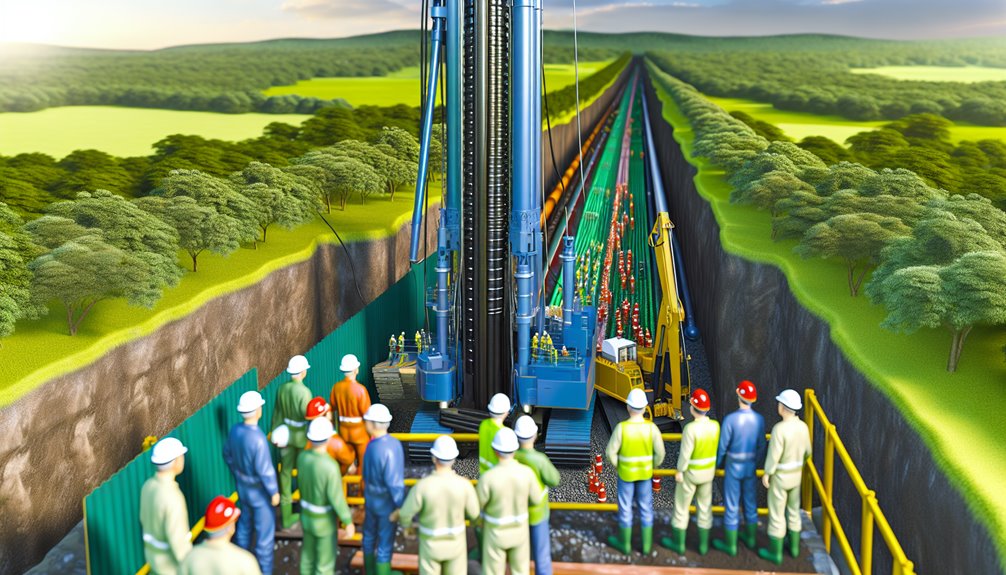
Horizontal Directional Drilling (HDD) has proven its value across various high-profile infrastructure projects, showcasing its ability to tackle complex challenges efficiently.
In San Diego, replacing a pipeline on Upas St. required HDD due to challenging topography. This project involved simultaneous pulling of a 762 mm casing and a 609.6 mm line, demonstrating HDD's effectiveness in constrained spaces.
Similarly, in a major US data center, HDD enabled the installation of multiple fiber-optic conduits across environmentally sensitive areas like creeks and wetlands, avoiding open trench methods.
Additionally, in water infrastructure, HDD's precision in directional control facilitated the deployment of ductile steel pipes, ensuring durable water systems and minimal environmental impact.
These cases highlight how HDD applications efficiently address diverse infrastructure challenges.
Future Trends and Innovations in Horizontal Directional Drilling Technology
As the demand for more sophisticated infrastructure solutions rises, innovations in Horizontal Directional Drilling (HDD) technology are rapidly advancing to meet these needs.
You're seeing a transformative shift towards:
- Automated Steering Systems: Utilizing real-time data and algorithms for precision.
- Enhanced Drilling Fluids: Eco-friendly formulations that meet stringent environmental standards.
- Advanced Drilling Rig Technology: Featuring compact, efficient, and terrain-navigating capabilities.
- Remote Monitoring and Diagnostics: Enabling real-time operational insights and proactive maintenance.
- Integrated Automation: Streamlining operations, reducing labor costs, and minimizing human error.
These drilling innovations not only boost efficiency and productivity but also guarantee that your projects are aligned with evolving environmental and regulatory demands.
Embrace these advancements to stay at the forefront of the construction and utility sectors.
Conclusion
As you've seen, Horizontal Directional Drilling (HDD) is integral to modern infrastructure, offering substantial environmental benefits and operational efficiency over traditional trenching. Its precision and reduced ecological footprint make it indispensable, especially in sensitive or densely populated areas. As technology advances, expect future HDD applications to become even more efficient and environmentally friendly. By staying informed on these trends, you'll be well-prepared to leverage HDD's evolving capabilities in your upcoming projects.
If you're curious to learn more about how HDD can benefit your projects, I invite you to visit Boring Bros at boringbro.com. You can also give them a call at (954) 639-6167. The team there is friendly and knowledgeable, ready to help you explore all the possibilities that HDD offers. Don't hesitate to reach out!

